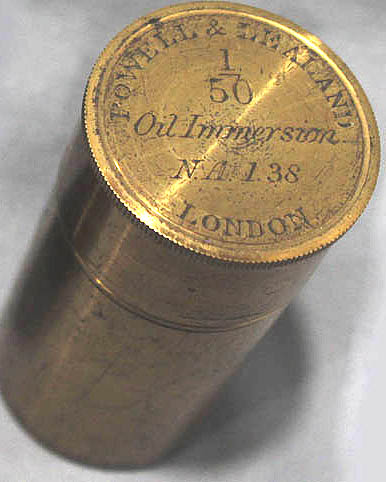THE FIRST P & L 1/50 INCH OIL IMMERSION OBJECTIVE WITH N.A. OF 1.38
MAKER:POWELL & LEALAND
SERIAL NUMBER: 1
c.1880

 This historically important achromatic oil immersion objective is signed:
This historically important achromatic oil immersion objective is signed:
Powell & Lealand No. 1,
Powell & Lealand 1/50 oil immersion,
N.A. 1.38
According to Bradbury, this objective was introduced in 1880.
The No. 1 is a serial number indicating this is the first example. Their first 1/50 oil immersion, the present example, was made in 1880, the same year as their first 1/25 with the same numerical aperture of 1.38 (also in this collection, but without a serial number).
HISTORY:
Although the technique of immersion of objectives was tried by Hooke and suggested by Sir David Brewster, immersion objectives using water were first made by Amici in 1843, though with the purpose of reducing aberration, not improving numerical aperture. In 1859 Hartnack made his first water immersion objective, and this led to its popularity; he was the first to add a correction collar to a water immersion objective. In 1867 Ernst Gundlach may have been the first to make glycerin immersion objectives. P & L made their first (dry?) 1/50 for Lionel Beale in 1864. In 1865, Powell & Lealand became the first to make water immersion lenses in England. Robert Tolles was the first to use a fluid with the same refractive index as glass, softened Canada Balsam, for oil immersion in 1871. By 1870, Zeiss, with the help of Abbe, was making all their objectives by calculation; in 1873, the year that Abbe published his scientific work on the resolution of objectives relating to numerical aperture, Tolles made his famous 1/10 inch homogenous immersion objective with a N.A. of 1.25. But Balsam was hard to work with and hardened with time and so was not ideal. Tolles made a glycerine immersion objective that same year. Glycerin has a lower refractive index than balsam, but at 1.47 it is higher than water at 1.33. In 1877 Abbe, after testing hundreds of liquids, discovered that Cedarwood oil has a refractive index(1.51) close to glass, and all his oil immersion lenses were then designed to work with this; within a few years Cedarwood Oil replaced softened Canada balsam for all oil immersion objectives. Powell & Lealand made their first oil immersion objective, a 1/12, in 1879. Their first 1/50 oil immersion objective shown above was made just one year later in 1880 with the published n.a. of 1.38, and the first example of that ojbective is the one featured at the top of this page.
Although cedarwood oil was used until the 1940's it has drawwbacks, including absorbtion of UV and yellow light and turning yellow with age; it is considered nontoxic however. In the 1940's synthetic immersion oils were developed by Cargille which did not harden nor turn colors. Although these oils seemed to be a big improvement, one drawback was that they contained carcinogenic PCBs (polychlorinated biphenyls) until 1971. Commercial immersion oil of today no longer contains these compounds. A little known fact is that the refractive index of immersion oils varies with temperature. Most modern oils are designed to be used at a 23oC (about 73.4oF).

 This historically important achromatic oil immersion objective is signed:
This historically important achromatic oil immersion objective is signed: